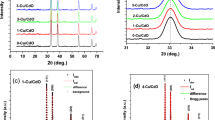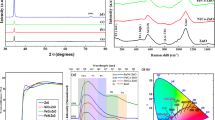Abstract
Zinc phthalocyanine (ZnPc) is a promising candidate for solar-cell applications, because it is easily synthesized and is non-toxic to the environment. Recently, phthalocyanine (Pc) was considered by many researchers as the active part in all-organic solar cells, i.e. plastic solar cells. It is a self-assembling liquid crystal developed from a common deep-blue-green pigment. It exhibits a characteristic structural self-organization, which is reflected in an efficient energy migration in the form of extinction transport. In this paper we have report structural, surface morphological, optical and thermal properties of flash-evaporated zinc phthalocyanine thin films. The samples were prepared by using a vacuum coating unit on well-cleaned glass substrates under a pressure of 7×10-6 Torr. A constant rate of evaporation (1 Å/s) was maintained throughout the evaporation of the ZnPc thin films. A rotary drive was employed to obtain uniform thickness during the evaporation. Thicknesses of the films were monitored by a quartz-crystal thickness monitor and were cross verified by the multiple-beam interferometry technique. The X-ray-diffraction pattern reveals the crystalline nature of the films deposited at higher substrate temperatures. Scanning electron microscope and scanning probe microscope nanoscope studies were carried out to determine the surface uniformity and homogeneity of the films for interfacing and application purposes. All the films were found to possess small crystallites less than 100 nm in size. The optical transmittance measurements were carried out using a spectrophotometer in the visible region (400–800 nm) and the films were found to be absorbing in nature. The band gap of the ZnPc thin films is 1.97 eV and the optical transition was found to be direct and allowed. The absorption coefficient, extinction coefficient and refractive index of the ZnPc films were evaluated and the results are discussed. Differential scanning calorimetry studies of ZnPc films were carried out and a phase transition from α to β was observed at 538 K.
Similar content being viewed by others
References
J. Ni, T. Tano, Y. Ichino, T. Hanada, T. Kamata, N. Takada, K. Yase: Jpn. J. Appl. Phys. 40, L948 (2001)
N. Uyeda, M. Ashida, E. Suito: J. Appl. Phys. 36, 1453 (1965)
P.A. Lane, J. Rostalski, C. Giebeler, S.J. Martin, D.D.C. Bradley, D. Meissner: Sol. Energy Mater. Sol. Cells 63, 3 (2000)
D. Wrobel, A. Boguta: J. Photochem. Photobiol. A: Chem. 6045, 1 (2002)
K. Oda, S.-I. Ogura, I. Okura: J. Photochem. Photobiol. B: Biol. 59, 20 (2000)
M. Ashida, N. Uyeda, E. Suito: Bull. Chem. Soc. Jpn. 39, 2616 (1966)
M.K. Debe, R.J. Poirier, K.K. Kam: Thin Solid Films 197, 335 (1991)
M.J. Stillman, T. Nyokong: Phthalocyanines, Properties and Applications, ed. by C.C. Leznoff, A.B.P. Lever (VCD, New York 1989) Chapt. 3
D. Meissner, J. Rostalski: Synthetic Metals 121, 1551 (2001)
Author information
Authors and Affiliations
Corresponding author
Additional information
PACS
78.20.-e; 65.90.+i; 61.16.Ch; 61.16.Bg
Rights and permissions
About this article
Cite this article
Senthilarasu , S., Velumani , S., Sathyamoorthy , R. et al. Characterization of zinc phthalocyanine (ZnPc) for photovoltaic applications. Appl Phys A 77, 383–389 (2003). https://doi.org/10.1007/s00339-003-2184-7
Received:
Accepted:
Published:
Issue Date:
DOI: https://doi.org/10.1007/s00339-003-2184-7




